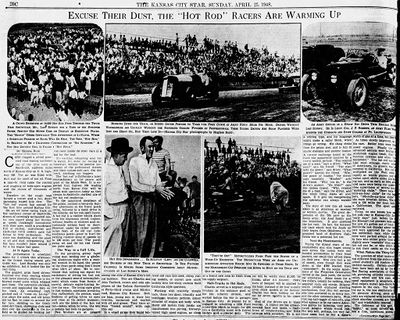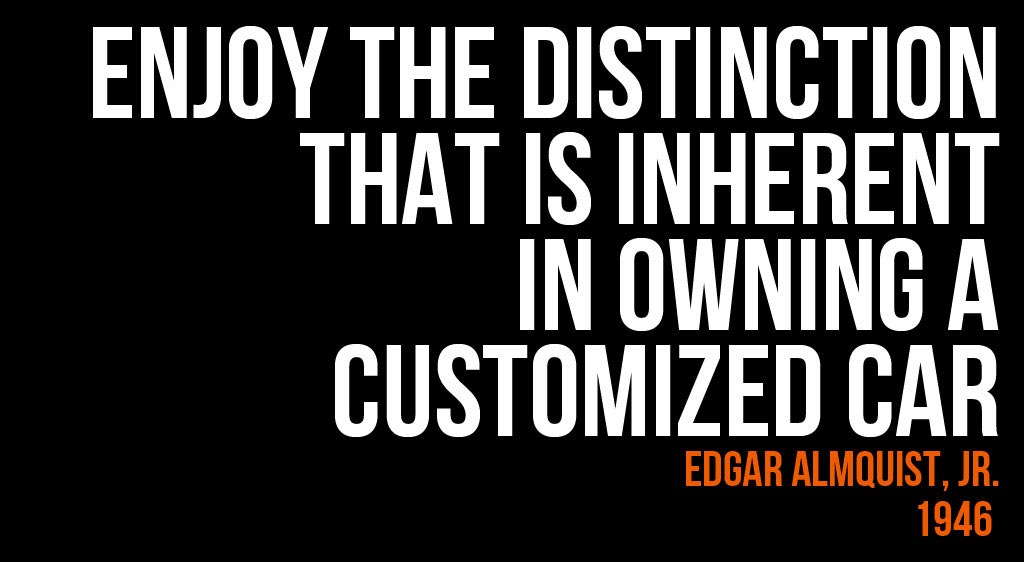Hot Rod

Contents
The History of Hot Rodding
As early as 1951 Wally Parks claimed that the beginning of the hot rod story was hard to trace. Wally wrote a story called "The History of the Hot Rod Sport" for Trend Book No. 102 Hot Rods, and according to that, hot rodding began somewhere in the late Twenties, "when some unknown automotive enthusiast stripped the fenders off his Ford, pulled the head of and milled it, painted descriptive names on the side, and was in business."[1]
A few years earlier, in 1948, Kansas City journalist Hughes Rudd published an in-depth newspaper feature on hot rodding outside of California. Writing for The Kansas City Star, Rudd described how the hot rod phenomenon had spread to Missouri and taken root among local mechanics and speed-hungry youth. His article traced the movement’s origins back to The Great Depression, when young Americans, priced out of new cars and armed with mechanical ingenuity, began rescuing and rebuilding junkyard wrecks.[2]
“The story of how this all came about is as American as baseball or western movies,” Rudd wrote. “The Great Depression of the '30s gave us the bonus army, the Joad family and the breadlines. It also spawned the hot rods.” Without money for factory-built machines, young men built their own, scrounging for orphaned steering boxes, tires, and spare parts. These cast-off creations may have run rough at first, but with time, tuning, and homemade speed equipment like dual carburetors and aluminum heads, they became the first hot rods.[2]
According to Rudd, California was the first to turn this backyard movement into an organized sport. By 1934, motoring clubs were hosting supervised races, and hot rod culture exploded across the West. From “50-mile-an-hour clubs” for beginners to “100-mile-an-hour clubs” for thrill seekers, the scene thrived under the California sun. Eventually, it began spreading eastward.[2]
By 1948, Kansas City’s hot rod scene had caught fire. Rudd noted that while there were a few hot rods before the war, the postwar years brought an explosion in interest. In the early days just before the war, the Missouri rod pioneers kept score, he wrote, but now it’s gotten out of hand. At a Sunday exhibition race held in Smithville, Missouri, about twenty cars were approved for racing while dozens more filled the infield—some more 'roadable' than others, but all part of the growing scene.[2]
Dry Lakes Racing
The first dry lakes races took place in the 1920s at Muroc and El Mirage. In the beginning, it was only adventurous motorists taking their hopped-up Model T's and beaters to take lake for some fast fun. The first speed trials were held at Muroc in 1927. Muroc was favored for its large area and hard surface. In 1931 time trials were organized by the newly formed Muroc Timing Association. In the beginning, a pace car led the racers, about five at the time, to speeds of maybe 50 miles per hour, before everyone took off at the start line. The car that first reached the finish line first was the winner. Often, only the driver in the lead could see clearly where he was going. Those behinds ran in the dust, making it hard to see anything at all. The runs became a quick hit, and the early dry lake trials could attract as many as 10 000 spectators. Most prewar lake racers were stripped to the chassis Ford Model As or Ts, or 1932 Ford Roadsters powered by a 200 cid Model A or B four-bangers.[3]
The Birthplace of Hot Rodding
According to Wally Parks, Glendale, Pasadena, Whittier and South Gate were the birthplaces of hot rodding.[4]
The Term "Hot Rod" Gets Coined
The term "Hot Rod" did not come into use until after WWII when it was picked up by journalists and used in a sensational manner. "Hot Rod" was probably an elision of "hot roadster." In the mid-1930s, before there were hot rods, there were "hot irons", "supe jobs" and "gow jobs".[4]
The History of Northwest Hot Rodding
According to Albert Drake, the unique development of hot rodding in the Northwest, particularly Oregon, was influenced by its proximity to California, the birthplace of hot rodding. Oregon's favorable climate and varied topography offered a perfect environment for the year-round driving and tinkering of hot rods. The tradition in the Northwest was characterized by ingenuity and a sense of craft. According to Tom "Stroker McGurk" Medley, Oregon had a reputation for "fine machines." The surge of hot rodding in the region was propelled by the lack of information, which led enthusiasts to rely on instinct and common sense to build high-speed, well-crafted machines. This movement gained momentum in the mid-20th century, paralleling the rise of publications like Hot Rod magazine that shared technical knowledge and fostered a community of like-minded builders and racers.[5]
References
- ↑ The History of Hot Rodding by Wally Parks - Trend Book No. 102 Hot Rods
- ↑ 2.0 2.1 2.2 2.3 The Kansas City Star, April 25, 1948
- ↑ So-Cal Speed Shop The Fast Tale of the California Racers who Made Hot Rod History
- ↑ 4.0 4.1 Flat Out
- ↑ Street Was Fun in '51 by Albert Drake
Did you enjoy this article?
Kustomrama is an encyclopedia dedicated to preserve, share and protect traditional hot rod and custom car history from all over the world.
- Help us keep history alive. For as little as 2.99 USD a month you can become a monthly supporter. Click here to learn more.
- Subscribe to our free newsletter and receive regular updates and stories from Kustomrama.
- Do you know someone who would enjoy this article? Click here to forward it.
Can you help us make this article better?
Please get in touch with us at mail@kustomrama.com if you have additional information or photos to share about Hot Rod.
This article was made possible by:
SunTec Auto Glass - Auto Glass Services on Vintage and Classic Cars
Finding a replacement windshield, back or side glass can be a difficult task when restoring your vintage or custom classic car. It doesn't have to be though now with auto glass specialist companies like www.suntecautoglass.com. They can source OEM or OEM-equivalent glass for older makes/models; which will ensure a proper fit every time. Check them out for more details!
Do you want to see your company here? Click here for more info about how you can advertise your business on Kustomrama.





